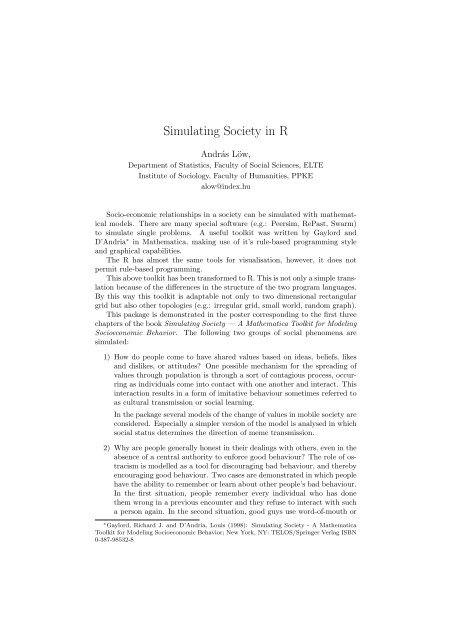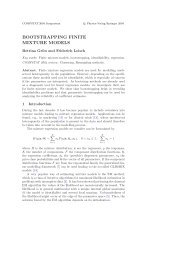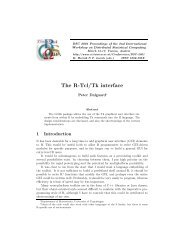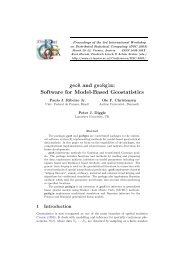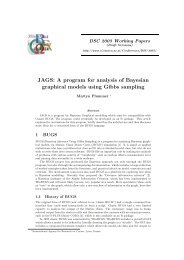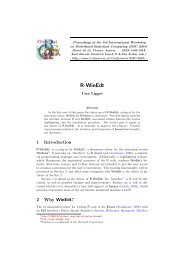Embedding R in Windows applications, and executing R remotely
Embedding R in Windows applications, and executing R remotely
Embedding R in Windows applications, and executing R remotely
Create successful ePaper yourself
Turn your PDF publications into a flip-book with our unique Google optimized e-Paper software.
Simulat<strong>in</strong>g Society <strong>in</strong> R<br />
András Löw,<br />
Department of Statistics, Faculty of Social Sciences, ELTE<br />
Institute of Sociology, Faculty of Humanities, PPKE<br />
alow@<strong>in</strong>dex.hu<br />
Socio-economic relationships <strong>in</strong> a society can be simulated with mathematical<br />
models. There are many special software (e.g.: Peersim, RePast, Swarm)<br />
to simulate s<strong>in</strong>gle problems. A useful toolkit was written by Gaylord <strong>and</strong><br />
D’Andria ∗ <strong>in</strong> Mathematica, mak<strong>in</strong>g use of it’s rule-based programm<strong>in</strong>g style<br />
<strong>and</strong> graphical capabilities.<br />
The R has almost the same tools for visualisation, however, it does not<br />
permit rule-based programm<strong>in</strong>g.<br />
This above toolkit has been transformed to R. This is not only a simple translation<br />
because of the differences <strong>in</strong> the structure of the two program languages.<br />
By this way this toolkit is adaptable not only to two dimensional rectangular<br />
grid but also other topologies (e.g.: irregular grid, small world, r<strong>and</strong>om graph).<br />
This package is demonstrated <strong>in</strong> the poster correspond<strong>in</strong>g to the first three<br />
chapters of the book Simulat<strong>in</strong>g Society — A Mathematica Toolkit for Model<strong>in</strong>g<br />
Socioeconomic Behavior. The follow<strong>in</strong>g two groups of social phenomena are<br />
simulated:<br />
1) How do people come to have shared values based on ideas, beliefs, likes<br />
<strong>and</strong> dislikes, or attitudes? One possible mechanism for the spread<strong>in</strong>g of<br />
values through population is through a sort of contagious process, occurr<strong>in</strong>g<br />
as <strong>in</strong>dividuals come <strong>in</strong>to contact with one another <strong>and</strong> <strong>in</strong>teract. This<br />
<strong>in</strong>teraction results <strong>in</strong> a form of imitative behaviour sometimes referred to<br />
as cultural transmission or social learn<strong>in</strong>g.<br />
In the package several models of the change of values <strong>in</strong> mobile society are<br />
considered. Especially a simpler version of the model is analysed <strong>in</strong> which<br />
social status determ<strong>in</strong>es the direction of meme transmission.<br />
2) Why are people generally honest <strong>in</strong> their deal<strong>in</strong>gs with others, even <strong>in</strong> the<br />
absence of a central authority to enforce good behaviour? The role of ostracism<br />
is modelled as a tool for discourag<strong>in</strong>g bad behaviour, <strong>and</strong> thereby<br />
encourag<strong>in</strong>g good behaviour. Two cases are demonstrated <strong>in</strong> which people<br />
have the ability to remember or learn about other people’s bad behaviour.<br />
In the first situation, people remember every <strong>in</strong>dividual who has done<br />
them wrong <strong>in</strong> a previous encounter <strong>and</strong> they refuse to <strong>in</strong>teract with such<br />
a person aga<strong>in</strong>. In the second situation, good guys use word-of-mouth or<br />
∗ Gaylord, Richard J. <strong>and</strong> D’Andria, Louis (1998): Simulat<strong>in</strong>g Society - A Mathematica<br />
Toolkit for Model<strong>in</strong>g Socioeconomic Behavior; New York, NY: TELOS/Spr<strong>in</strong>ger Verlag ISBN<br />
0-387-98532-8


